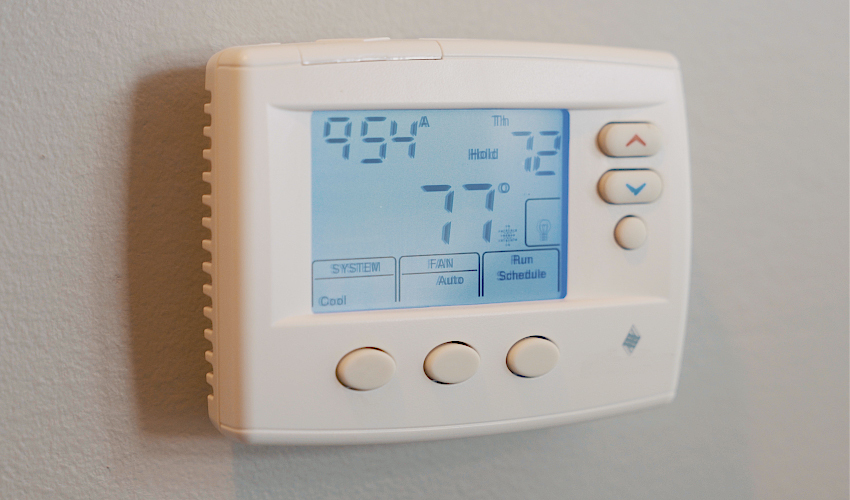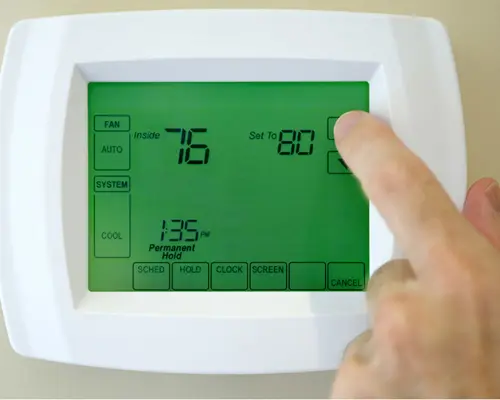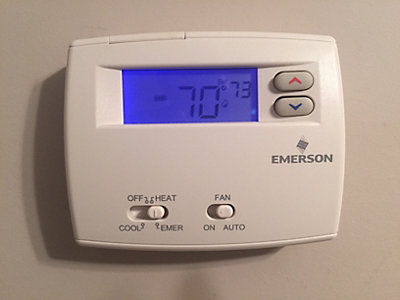Check Best Thermostat Pricing in Amazon
** As an Amazon Associate, I earn from qualifying purchases.
Winter is here, and with it comes the annual debate of what to set your thermostat on to keep cozy without breaking the bank. You might find yourself bundled up in layers or, on the flip side, cranking up the heat until your energy bill sends shivers down your spine.
But what if there was a perfect balance, a sweet spot that not only keeps your home at the ideal temperature but also saves you money? Imagine sipping your hot cocoa, snug in your living room, knowing you’ve mastered the art of thermostat setting.
We’ll uncover the optimal thermostat settings for winter, tailored just for your needs. You’ll learn how to stay warm, save money, and make your home a winter haven. Ready to transform your winter experience? Keep reading to discover how small adjustments can lead to big comfort.

Credit: www.aireserv.ca
Optimal Temperature Settings
Finding the right temperature for your thermostat in winter is crucial. It helps maintain comfort and energy efficiency in your home. Setting the thermostat correctly can save money on heating bills. It also ensures a cozy and warm environment during the cold months. Let’s explore the optimal temperature settings for different times of the day and night.
Daytime Recommendations
During the day, set your thermostat between 68°F to 72°F. This range keeps your home warm without excessive energy use. Lower temperatures can be uncomfortable for most people. Adjust the setting based on your personal comfort level. If you’re out, reduce the temperature to save energy. A smart thermostat can make these adjustments automatically.
Nighttime Adjustments
At night, you can lower the thermostat slightly. A temperature between 60°F to 67°F is ideal. Cooler air can help improve sleep quality. Use warm blankets and pajamas for added comfort. Lowering the thermostat at night saves energy. It reduces heating costs significantly. Consider using a programmable thermostat for easy adjustments.

Credit: www.ars.com
Energy Efficiency Tips
Winter brings cold weather, often leading to higher energy bills. Lowering energy costs is important during these chilly months. Adjusting your thermostat wisely can help save money. Smart settings ensure your home stays warm without wasting energy. Let’s explore some tips for energy efficiency.
Programmable Thermostats
Programmable thermostats can be a great tool. They allow for easy temperature adjustments throughout the day. You can set lower temperatures when nobody is home. Warmer settings can be programmed for when you return. This reduces energy consumption significantly. Many models offer smartphone control for convenience. This feature helps manage home temperatures remotely.
Zoning Systems
Zoning systems are effective in large homes. They let you control temperatures in different areas. This means you can heat only the rooms you use. Zoning systems reduce energy waste. Rooms not in use can have lower temperatures. This approach enhances comfort and efficiency. Installing a zoning system may require professional help. It is worth considering for long-term savings.
Comfort Vs. Cost
Finding the balance between comfort and cost is crucial when setting your thermostat in winter. A cozy home often means higher bills, but adjusting your settings wisely can help save money without sacrificing warmth. Aim for a temperature that keeps you comfortable while reducing energy consumption.
In winter, finding the right thermostat setting means balancing comfort with cost. Many households face this annual challenge. Adjusting the thermostat affects both your comfort and your utility bills. Understanding how to strike this balance can save money and keep your home cozy.Balancing Comfort
The ideal temperature keeps everyone comfortable. Most people feel good at around 68°F. This setting is often considered the sweet spot for warmth. It prevents the home from feeling too cold. You can also wear warm clothes to increase comfort. Consider using blankets and warm socks. This way, you can lower the thermostat a bit more. Each degree lowered can save energy and reduce bills.Understanding Utility Bills
Utility bills can rise in winter. Heating accounts for a large portion of these costs. Lowering the thermostat by one degree can save about 1% of your bill. Programmable thermostats help manage costs efficiently. Set them to lower temperatures when you’re asleep or away. This reduces energy use without sacrificing comfort. Keeping an eye on usage can help identify savings opportunities. Energy-efficient habits make a big difference. Sealing drafts and insulating windows also help keep heat in. These simple changes can improve comfort and reduce costs.Impact On Health
Setting your thermostat between 68°F and 72°F in winter can positively affect health. Proper temperature regulation helps prevent colds and supports better sleep. A comfortable environment aids in maintaining overall well-being during colder months.
Setting your thermostat during the winter months is more than just a matter of comfort. It directly impacts your health. You may not realize it, but the temperature in your home influences your well-being in several ways. Let’s explore how your thermostat settings can affect your health, focusing on humidity levels and air quality considerations.Humidity Levels
Maintaining proper humidity levels in your home is crucial during winter. When your thermostat is set too high, the air can become overly dry. This can lead to dry skin, irritated eyes, and even respiratory issues. A simple humidifier can help balance humidity levels. Aim for a humidity level between 30% to 50%. This range can prevent the drying effects of heated air. Have you ever woken up with a scratchy throat? It might be due to low humidity caused by high indoor temperatures. Adjusting your thermostat can make a big difference.Air Quality Considerations
Your thermostat setting also affects the air quality inside your home. Higher temperatures can increase the concentration of indoor air pollutants. This includes dust mites and mold, which thrive in warm environments. Ensuring good air circulation can help. Regularly change your air filters and consider an air purifier. These simple actions can dramatically improve your indoor air quality. Have you noticed more sneezing or headaches in the winter? Poor air quality might be the culprit. Adjust your thermostat and improve ventilation to breathe easier. Finding the right balance on your thermostat isn’t just about saving on energy bills. It’s about creating a healthy living space for you and your family. How will you adjust your settings this winter for better health?Smart Thermostat Benefits
Setting your thermostat to 68°F in winter can save energy and reduce heating costs. Smart thermostats make adjustments easy, keeping your home comfortable. They learn your schedule and preferences, offering convenience and efficiency.
Check Best Thermostat Pricing in Amazon
** As an Amazon Associate, I earn from qualifying purchases.
Remote Control Features
Smart thermostats allow remote temperature adjustments. You can control your home’s heating from anywhere. Use your smartphone or tablet to change settings. This is perfect for adjusting heat before arriving home. It saves energy and keeps your house cozy.Energy Usage Monitoring
Monitoring energy usage is easy with smart thermostats. They provide detailed reports on heating patterns. Know exactly how much energy your home uses. This helps in identifying ways to save money. Adjusting heat based on usage data optimizes efficiency.
Credit: plumblineservices.com
Common Mistakes
Setting the thermostat correctly during winter saves energy and money. Many homeowners make common mistakes. These errors lead to discomfort and higher bills. Understanding these mistakes helps maintain a cozy home and efficient heating.
Overworking The System
Many set the thermostat too high, thinking it heats faster. This overworks the system and wastes energy. The heater runs longer than necessary. Instead, set it to a reasonable temperature. Let the system work steadily. This maintains warmth efficiently.
Frequent adjustments confuse the system. The heater struggles to keep up. Constantly changing the temperature uses more energy. Choose a comfortable setting and stick with it. This reduces strain on the system.
Ignoring Maintenance
Regular maintenance keeps heating systems efficient. Many ignore these checks. Dust and dirt build up, affecting performance. Clean or change filters regularly. This ensures the system runs smoothly.
Unchecked systems face wear and tear. This leads to unexpected breakdowns. Schedule annual maintenance checks. Professional technicians spot potential issues. This prevents costly repairs and keeps systems running well.
Frequently Asked Questions
Is 74 Too High For Heat In Winter?
Setting the heat to 74°F in winter is common and comfortable for many. It depends on personal preference and energy efficiency goals. Consider insulation and weather conditions to optimize warmth and cost.
What Should I Set My Thermostat On In Extreme Cold?
Set your thermostat to 68°F (20°C) during the day in extreme cold. Lower it to 60°F (15°C) at night for efficiency. This maintains comfort and energy savings, ensuring your system works efficiently. Adjust based on personal comfort and home insulation.
What Is The Best Thermostat Schedule For Winter?
Set your thermostat to 68°F during the day and lower it to 60°F at night. Adjust based on comfort and energy savings. Regularly check and maintain the system for efficiency. Use programmable thermostats for convenience. Optimize your settings to balance warmth and cost-effectiveness in winter months.
Is It Cheaper To Leave Your Thermostat At One Temperature?
Keeping your thermostat at a constant temperature can be cheaper. Frequent adjustments may cause your system to work harder, increasing energy costs. Consistent settings help maintain efficiency, potentially reducing your heating or cooling bills.
Conclusion
Finding the right thermostat setting in winter saves energy. It keeps you comfortable and helps lower bills. Set it around 68°F when home. Lower it a bit when you sleep or leave. Small adjustments make big differences. Remember, wear warm clothes to feel cozy.
Regular maintenance ensures your heating system works efficiently. This way, you enjoy warmth without high costs. Consider using a programmable thermostat for convenience. It adjusts settings automatically. Stay warm, save money, and keep your home cozy. Simple steps lead to a comfortable winter.
Check Best Thermostat Pricing in Amazon
** As an Amazon Associate, I earn from qualifying purchases.

